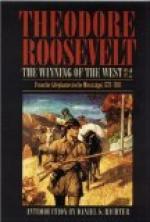It will be seen that these returns are imperfect. They do not include Shelby’s loss; yet his regiment was alongside of Campbell’s, did its full share of the work, and probably suffered as much as Sevier’s, for instance. But it is certain that in the hurry not all the killed and wounded were enumerated (compare Draper, pp. 302-304). Hayes’, Thomas’, and “Brannon’s” (Brandon’s) commands were some of those joining at the Cowpens. Winston’s loss is doubtless included under Cleavland’s. It will be seen that Williams’ troops could have taken very little part in the action.] Campbell’s command suffered more than any other, the loss among the officers being especially great; for it bore the chief part in withstanding the successive bayonet charges of the regulars, and the officers had been forced to expose themselves with the utmost freedom, in order to rally their men when beaten back. [Footnote: It would be quite impossible to take notice of the countless wild absurdities of the various writers who have given “histories” so-called, of the battle. One of the most recent of them, Mr. Kirke, having accepted as the number of the British dead two hundred and twenty-five, and the wounded one hundred and eighty five, says that the disproportion shows “the wonderful accuracy of the backwoods rifle”—the beauty of the argument being that it necessarily implies that the backwoodsmen only fired some four hundred and ten shots. Mr. Kirke’s account of the battle having been “won” owing to a remarkable ride taken by Sevier to rally the men at the critical moment is, of course, without any historic basis whatever.]
After the Victory.
The mountain-men had done a most notable deed. They had shown in perfection the best qualities of horse-riflemen. Their hardihood and perseverance had enabled them to bear up well under fatigue, exposure, and scanty food. Their long, swift ride, and the suddenness of the attack, took their foes completely by surprise. Then, leaving their horses, they had shown in the actual battle such courage, marksmanship, and skill in woodland fighting, that they had not only defeated but captured an equal number of well-armed, well-led, resolute men, in a strong position. The victory was of far-reaching importance, and ranks among the decisive battles of the Revolution. It was the first great success of the Americans in the south, the turning-point in the southern campaign, and it brought cheer to the patriots throughout the Union. The loyalists of the Carolinas were utterly cast down, and never recovered from the blow; and its immediate effect was to cause Cornwallis to retreat from North Carolina, abandoning his first invasion of that State. [Footnote: “Tarleton’s Campaigns,” p. 166.]




